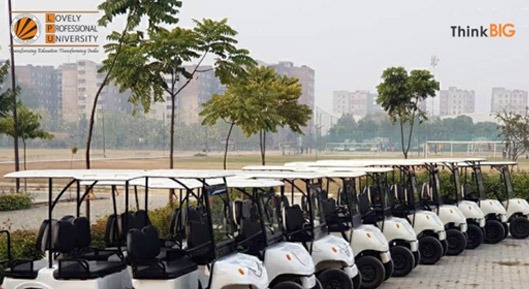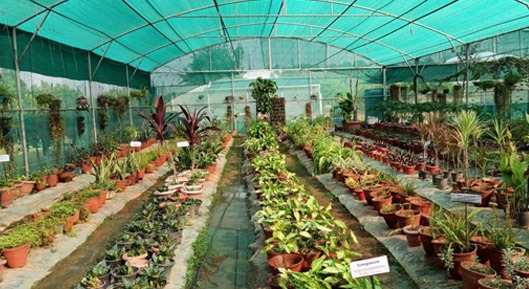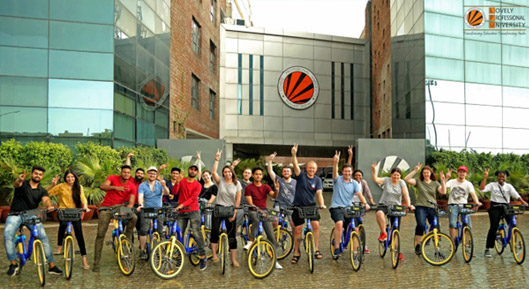
ACADEMIC AND RESEARCH INITIATIVE
Curriculum Initiatives: terms of academic activities, LPU has launched an environment-based course with exposure to 8000 students in an effort to instil a sense of social responsibility in our children. In order to address societal problems specifically related to these 10 categories—environmental studies, yoga, renewable energy, sustainable agricultural practises, pollution management, recycling and reuse of waste, social awareness, disease management, innovative teaching methods, and e-resource development—community development projects are introduced to various domains with a reach of 6000+ students.
Related Innovations by Students
- LPU Students designed and built a solar car that claims to do away with costly fuel options and promises the ‘highest milage on solar energy’. It is completely pollution free.
- In contribution to this, recently, LPU Students has designed and created a unique solar-powered driverless bus that is completely pollution free and uses only renewable energy in the form of electric motor and solar power for propulsion. Vehicle-to-Vehicle (V2V) communication technology has been used to make the bus driverless. The bus also uses GPS and Bluetooth for navigation and could be controlled within a radius of 10 metres. The technology works by using wireless signals detected through ultrasonic & Infra-red sensors.
- Acting upon the issue of pollution in various cities across the country, LPU students, Ashutosh and Laxmi have developed the ‘Bio Air Purifier’. The prototype device effectively helps in reducing pollution by converting harmful greenhouse gases into useful oxygen with zero-waste generation. The device is suitable for both domestic as well as industrial useful oxygen with zero-waste generation. The device is suitable for both domestic as well as industries.
FRAMEWORK AND GUIDELINES:
Being a responsible organization, LPU is working to minimise carbon emissions through a number of initiatives, including the use of bicycles, solar panel installations, and sewage treatment plants. To encourage food with a high nutritious content, LPU produces its own organically from our
EDUCATION LOAN ASSISTANCE
The university has set up a separate loan assistance cell to enable the students, at the time of admission, to obtain loans from banks with which the university has tie ups. Students can avail Education Loan Facility in the first year as well as in the subsequent years.
Renewal energy Initiatives
Lovely Professional University is aware that using solar energy reduces both water scarcity and air pollution. For that reason, LPU created 1.1 MW of solar panels in 2018 in response to the significant and favourable effects of solar energy on the environment. Currently, 7.5 MW of solar power plant is installed in the university.
All forms of energy have their origin in solar energy. There are two ways to utilise this energy: thermally, which involves using heat to dry, heat, cook, or generate electricity; or photovoltaically, which involves turning solar energy into electricity, which can then be used for a variety of tasks like lighting, pumping, and electricity generating. With its pollution free nature, virtually inexhaustible supply and global distribution- Solar energy is a very desirable source of energy.
- Lovely Professional University has a dedicated 66 kV feeder from PSPCL with sanctioned load of about 18,000 kW and Contract Demand of nearly 12,000 kVA. Power supply is catered to the buildings is through nearly 14 nos of 11 kV Substations.
- A second source of 11 kV supply is also available from Substation Chaheru to be utilized in the event of failure of 66 kV.
- Apart from the above total, more than 9500 kVA, standby power is also available from Diesel Generators.
- The University’s commitment to guidelines contributes to the United Nations’ sustainable development goals, and it’s worth noting that in 2018, the University erected a 1.1 MW rooftop solar PV plant. Currently, 7.5 MW of Solar power plant is installed in the university. With these initiatives, Not only has the university lowered the total power use from the conventional resources, but it has also boosted the university’s renewable generation. In the year 2022, the combined emissions from scope 1 and scope 2 amount to nearly 3730 tonnes of CO2 equivalent for the 2021-22 session.
Solar Irrigation System:
- Three units of solar-based irrigation systems were installed by University. Each unit is of the capacity of 5 horsepower. The drip irrigation system is assembled with these motors to irrigate orchards. This system is highly efficient to minimize the loss of water and efficient use of energy and water resources.
Centralized Chiller Plant:
- In administrative blocks, the University replaced split and windows ACs with 265 TR centralized chiller water-based cooling system. The new system consumes 40% less electrical energy as compared to conventional AC’s.
- In the year 2019, 5644 conventional lighting systems of 53W and 108W were replaced by using 20W and 36W energy-efficient system, respectively. As mandatorily, hostel blocks are installed with 25W LED lamps in hostel rooms and hostel toilets & corridors are installed with 9W LED lamps and that will follow in future also. In the year 2022, 100% lights were replaced with LED in academic buildings and 48% in residential buildings. Street and security lights are switched on and off as per the session of the year to make use of the daylight. For the conservation of energy 50% streetlights have been switched off at 11:00 PM and another 25% have been switched off at 12:00 AM
Biogas plant:
- A biogas plant based on ‘Deenbandhu model’ is constructed to produce biogas from cattle dung. To reduce greenhouse gas emissions and the risk of pollution to waterways, organic waste can be removed and used to produce biogas, a renewable source of energy. Biogas contains roughly 50-70% methane, 30-40% carbon dioxide, and trace amounts of other gases. The University currently has 3 cubic meter operating biogas systems across the campus to process kitchen waste. Apart from the cattle dung, sewer waste is also fed in to the plant to produce biogas.
- In an era of smart cities, sustainable buildings and contemporary interiors, University designed an energy-efficient building with specialized architects. They have also trained LPU students to become lateral thinkers by focusing on the critical design approach. With exposure to an international environment, access to the latest tools, software’s and technology, LPU students also become architects that create buildings and infrastructure that are globally acknowledged. Due to the incorporation of energy-efficient building strategies, the energy consumption density of the LPU buildings is much lower than a 5 star rated building by Bureau of Energy Efficiency, Government of India.
- Solar power bus and battery-operated e-rickshaw in the campus are operating since 2017. 22 e-rickshaws service connecting its major buildings, departments, hostels for students and faculty members. Nearly 100 Km mileage is giving by each e-rickshaw. In this way, the university strives to combat the detrimental carbon-emitting conventional fuel vehicles and helping towards the improvement of air quality at the micro-level. LPU has also reduced its uses of powered vehicle among faculties by promoting and encouraging car-pooling, students are not allowed to used powered vehicle during class hour rather they have been using bicycle. LPU also uses battery operated auto for in-campus transportation for students and faculties.
Rain water harvesting with more than 35 reverse bores at Lovely Campus to take Rain water underground and to raise the water table has been installed, so as to help to control the shortage of water in the campus. Sensing the need for convenient transportation facilities for students, LPU has adopted an eco-friendly bicycle sharing system in 2018 across the campus. For this, LPU has collaborated with ‘Hero Cycles’ for a unique ‘bike sharing program’ at the campus. Because of the success of this system, LPU has been declared as the country's first ‘Bicycle Friendly University’. Near 600 bicycles are made available to the students, on 15+ stands across the campus, which are shared by near 4000 students per day.
Green initiative by LPU
Being a top-notch educational institution, Lovely Professional University has developed into a "Green Campus" with large operational function systems. Being a Green Campus:
- LPU carries out the functions in accordance with the environmental sustainability, where environmentally conscientious practice and education go hand in hand and where environmentally responsible tenets are borne out by example.
- As a leader, LPU is a laboratory of self-scrutiny, experimentation, and application.
- At its best, it is an exemplary environmental community and offers the opportunity to take the lead in rethinking its environmental culture and developing new paradigms.
- Greenifying the campus is about sweeping away wasteful inefficiencies and ushering in positive changes that includes many practical aspects of campus life, such as correct disposal, handling, purchase of environmentally friendly materials, effective recycling programs, etc.
- This is manageable and stepwise process with an aim toward continually improving the campus and implementing responsible recommendations.
Landscaping of the Campus
Since its creation, the area's landscaping has received particular attention. There have been year-by-year efforts made to plant new plants, and as of now, more than 100,000 plants have been planted.
- Planting of Attractive Plants: The campus has been planted with a variety of ornamental plants, including palm trees, roses, and more.
- Planting of Potted Flowering and Foliage Plants: In addition to the planting of trees and upkeep of the green belt, a variety of kinds of plants have been cultivated in the pots that are scattered throughout the campus.
Development of Farms on campus
Hi-Tech Poly House, Naturally Ventilated Poly House, Poly Tunnels, and Shade Net House are examples of infrastructure that the university has built. These structures are used for hands-on training, experiential learning, project work, and the commercial crop production industry.
- A more than 6000 square foot hi-tech poly house with a fan pad system for cooling and temperature control and a misting facility for controlling humidity inside the chamber. In addition to this, a pair of Polytunnels with dimension of more than 10,000 sq. ft. is used for conducting dissertation, project and Hands-on-Training activities by the students.
- A facility called Saw Tooth Naturally Ventilated Poly House with a floor area of more than 10,500 square feet is available for instruction in the growth of ornamental plants and the production of commercial horticulture crops.Shade Net House of an area of more than 5,400 sq. ft. is available for providing practical skill, Hands-on-Training practices on ornamental plants.
- Germination Chamber with area of nearly 2,700 sq. ft. is available to provide controlled environment for inducing germination in seeds.
Instructional farmland is further demarcated into for conduct of practical’s and Hands-on Training for the students of Agriculture and for research work.
- Nursery Unit: University has more than 5,300sq. ft. area for nursery of ornamental plants and about 12,900 sq. ft. area for fruits and forestry species. The nursery area is used to raise rootstocks of fruit species for providing students hands-on grafting and budding practices in guava, mango, ber, jamun etc. The cutting of popular, eucalyptus, grapes, mulberry, fig, pomegranates etc. have been developed by the students during practical’s. The nursery developed is used for teaching and research and is under the process of expansion
- Fruit Orchard: The dedicated area have been developed as orchard where fruits of various climatic zones have been grown. The common fruits like Guava and Kinnow have been grown in larger area while other plantations include Jamun, Aonla, Pear, Peach, Plum, Papaya, Banana, Pomegranate and Grapes are also available in requisite area which ensure satisfactory conduct of practicals and research.
- Floriculture and Landscaping unit: The University has a good collection of annual and perennial ornamental plants which includes more than 100 species and is used for providing practical skills and hands-on-training on propagation, potting, intercultural practices etc
- Sericulture: Mulberry plantation has been done and more than 1,000 plants for initiating sericulture unit to provide practical input and experiential learning to students.
Recycling of Sewage Water & Agro waste
One 5 MLD [Mega Liters per Day] and two 10 KLD STP facilities are located on campus for the treatment of sewage, and the full treated water is distributed throughout the institution through a 4 inch diameter, more than 1 KM long pipeline that was installed inside the campus. Through a variety of tributaries from the pipeline, the water is subsequently used for irrigation and horticulture purposes, i.e. watering the plants and vegetation in the campus.The sludge obtained is composed and used as manure in horticulture
- Agro composting has been taken up in campus to produce compost from the Horticulture waste. Therefore, a composting pit have been provided in University to make compost of Horticulture wastes such as leaves, branches, etc.
- The compost is used to supply nutrients to plantation in the University.
- Moreover, the compost improves soil structure, provides a wide range of nutrients for plants, and adds beneficial microbes to the soil.
CAMPUS ENGAGEMENT ACTIVITIES.
Campus engagement events give students a forum for connecting with and interacting with one another, which promotes learning and improves growth. As holistic development is the primary objective of extracurricular activities on college and university campuses, these activities are carried out to ensure the students' emotional, intellectual, social, and interpersonal progress. Students gain skills in negotiation, communication, conflict management, and leadership through teamwork. Participating in these extracurricular activities helps kids develop their critical thinking abilities, time management skills, and academic and intellectual competency. Participation in events encourages student contact, the development of relationships, and conversation.
Future Plans 2029
The goals for the green campus have been set for the 2029 vision while adhering to both national and international standards. According to the institution's 2029 vision, "by 2029, we must turn the university into the campus that is green and sustainable." Key Performance Indicators (KPIs) to gauge progress toward the "2029" goal
- Reduction the use of conventional energy resources by 30%.
- Identification of high energy consumption zones.
- Follow the national/international standards in building infrastructure and use of electric gadgets.
- Updation of existing infrastructure into the energy-efficient green buildings.
- Enhanced value creation through optimized material flows and waste management.
- Identification of essential and non-essential operation
- Promotion of 100% technology-driven green commuting system within the campus.
- Efficient management and conservation of water resources by 25%.
- Implementation of water recycling techniques including dissolved air flotation, biological treatment, granular activated carbon, softening, disinfection, deionization and filtration etc.
- Training and awareness for the utilization of recyclable materials and waste management
- Biodiversity, habitats and cultural heritage - conservation for current and future generations.
- Collaboration with NGOs, guidelines organisations and research organisations to explore the dynamics, issues and logistics of developing green and sustainable energy sources.
- Sensitization of students, staffs and local community by conducting regular outreach and awareness programs.
- Establishment of CoE in the area of Clean Energy.
- Promotion of collaborative research with industries related to the energy sector to develop more efficient renewable energy production system
- Creepers vertical greening strategies for saving energy and reduction of urban heat island effects.







